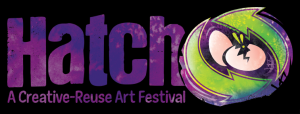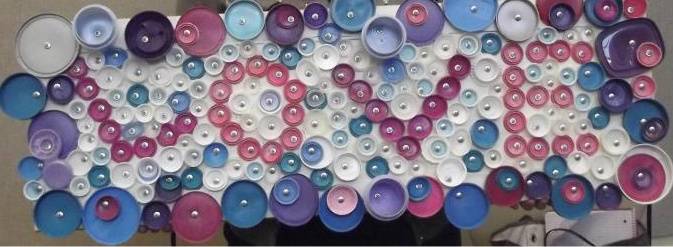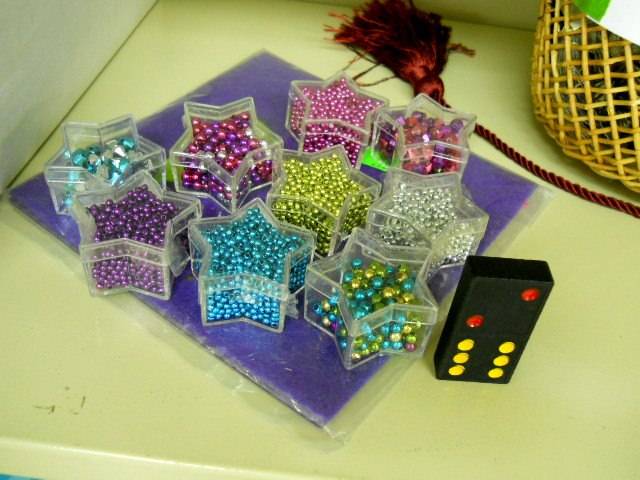
Squirrel tails, bed springs, teeth from various species (including humans), and even hairballs are among the many unconventional items found at The I.D.E.A. Store. In hopes of interrupting the waste stream, The I.D.E.A. Store, a marketplace of donated materials, encourages the creative reuse of such items. Furthermore, to raise awareness on the importance of recycling and the benefits of ecological art, the store will celebrate its first-ever art festival, HATCH, that includes a juried art exhibit and art fair, from March 1–3 at Indi Go Artist Co-op and the McKinley Fitness Center.
Over forty participating artists and designers will have work on display at Indi Go Artist Co-op during the three-day festival, which will extend through March 17. HATCH will kick off with a public reception from 5:00–7:00 p.m. on March 1 followed by artist-in-residence Michelle Stitzlein’s lecture regarding her artwork. A $5 suggested donation fee at the reception would cover Stitzlein’s lecture and the $2 fee for the art fair that will take place at the McKinley Fitness Center on March 2 from 10:00 a.m.–6:00 p.m.
 “I wanted to produce this festival because there isn’t anything like it here in C-U or in downstate Illinois,” Gail Rost, The I.D.E.A. Store general manager, said. “I think if people see it, they will be intrigued and inspired. It is just really cool and definitely part of the future to reuse. There just aren’t enough raw materials on our planet to throw stuff away — and there isn’t really any more room. Reuse is a fun way to have an impact on the world’s future. It feels good to be clever!”
“I wanted to produce this festival because there isn’t anything like it here in C-U or in downstate Illinois,” Gail Rost, The I.D.E.A. Store general manager, said. “I think if people see it, they will be intrigued and inspired. It is just really cool and definitely part of the future to reuse. There just aren’t enough raw materials on our planet to throw stuff away — and there isn’t really any more room. Reuse is a fun way to have an impact on the world’s future. It feels good to be clever!”
Many of the art pieces will be on sale. Among the exhibition pieces will be Lawrence Agnello’s “1926 Staghead Guitar” made from an antique seeder gear plate, antique telegraph and clock parts, an antique crank handle and hand drill, and vintage gauges. Agnello is one of two artists distinguished by having three pieces juried into the exhibition, the other being Cindy Sampson. Additionally, the art fair will include bottle-cap jewelry made by Chicago artists Jeanmarie Petro and Barbara Tinger, and jewelry made of plastic water bottles and other reusable materials made by Champaign-Urbana artist Mary Tangora.
Select participating artists will take part in a gallery talk moderated by 40 North’s Kelly White from 2:00–4:00 p.m. on March 3. Both Stitzlein and Rost hope that the event’s efforts are carried on throughout the community. “I want people who attend the various activities of the festival to get challenged,” Rost said. “I want them to think about reuse in a new way. I want them to really consider reusing what they have and shopping reuse for what they don’t have.”
Stitzlein, an Ohio-based artist and designer known for her mammoth moth sculptures (currently on view at the Center of Science and Industry in Columbus, Ohio), and her bottle cap work, will have two of her sculptures on display. With few recycling companies accepting caps, due to the chemical compounds that vary from cap to cap among other factors, Stitzlein has found ways to make the most of bottle caps; she has created items ranging from garden ornaments to jumbo refrigerator magnets.

On Friday, March 1, Stitzlein will conduct a mural-building project at South Side Elementary School. She will then lead an adult “Mini Bottle Cap Mural” workshop on March 2. Advanced registration and a $30 payment are required to reserve a space in the workshop:
I hope that the art educators will take their experience back to their schools and create a large-scale project with their students,” Stitzlein said. “I think that it is critical to teach children about our resources and their limitations for the benefit of the future. I also enjoy watching the fearless approach to creating that young children have. It is refreshing to see them in action and they usually produce beautiful, untainted, pure art.
Over the years, Stitzlein has collected items such as old pianos, bicycle and car parts, broken china, bottle caps, rusty pots and pans, plastic toys, and jar lids. She occasionally goes to a closed dumpsite that is located in an off-road ravine in a local park nearby and gathers materials from friends and family when they clean out their homes.
 “My ultimate goal is to create work that has the capacity to cause people to pause, to be visually intrigued or even stunned,” Stitzlein said. “They may have first admired the work for its beauty, only to realize after a few more seconds of study, that it is, indeed, made with landfill material. Hopefully, the ability to admire beauty in trash is a valuable and memorable experience.”
“My ultimate goal is to create work that has the capacity to cause people to pause, to be visually intrigued or even stunned,” Stitzlein said. “They may have first admired the work for its beauty, only to realize after a few more seconds of study, that it is, indeed, made with landfill material. Hopefully, the ability to admire beauty in trash is a valuable and memorable experience.”
Small purchases in the festival can make a great impact in the environmental community because materials that would typically end in the trash are recycled into new pieces of creative art. Proceeds from the festival will go towards the Champaign-Urbana Schools Foundation and The I.D.E.A. Store. For more information regarding HATCH go here or read the news release.
Photos from The I.D.E.A Store’s Facebook page.








